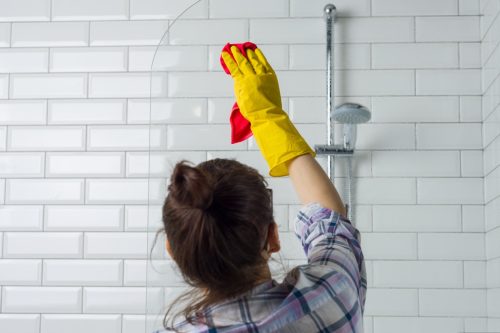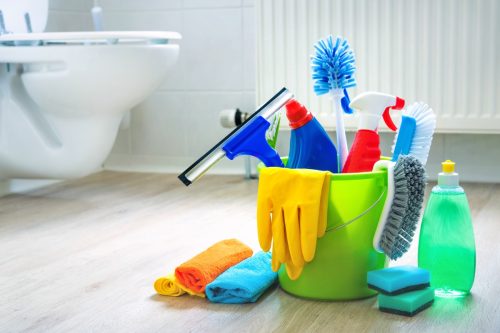6 Mistakes You’re Making That Cause Mold to Grow in Your Bathroom, According to Experts

As a homeowner (or a renter), one of the last things you want to deal with is mold. Not only is it a terrifying sight to see, but it can make you and your family sick, as well as weaken your walls and ceilings. Your bathroom is particularly susceptible to mold as this ugly fungus thrives in dark and damp places.
“Mold is a lot easier to prevent than it is to remove, so I suggest taking all the necessary precautions to avoid dealing with this problem [before it starts],” Tim Wells, founder of Garage Transformed tells Best Life.
Read on to discover the mistakes that could be making your mold situation much worse, according to cleaning experts.
READ THIS NEXT: If Your Plants Are Dying, This Simple Trick Will Revive Them.
1
Leaving things on the bathroom floor.

Sometimes you’re in a rush and you may forget to hang a towel up after your morning shower or you leave your damp gym clothes in a heap on the bathroom floor. It happens to the best of us from time to time, but it is not doing you any favors when it comes to keeping mold at bay.
Beth McCallum, a writer for Oh So Spotless tells Best Life, “Don’t leave towels, cloths, or loofah’s on the floor. Hang them up to dry. This allows them to air out properly so mold can’t take hold.”
By leaving damp items on the floor even for just a bit, you’re basically inviting mold to to grow—and the same goes for your products. Shower caddies are not only great for saving space, keeping bottles off the shower floor (and closed) is another key to mold prevention. “Leaving your shower products on the floor stops them from drip drying,” says McCallum. “Soon, you’ll notice mold gathering on the bottom, the seal, and the lid of your favorite products.”
2
Not cleaning your bathroom once a week.

Your bathroom is easily one of the most germ-filled places in your home, so not cleaning it regularly can lead to fast mold growth—and boy does it grow fast. After encountering moisture, mold can begin to grow in only 24 hours if it’s the right environment (ahem, a dirty bathroom).
So, how often should you be cleaning it? Phi Dang, the director of the professional home service Sidepost, says this should be a weekly endeavor. “Mold loves damp, dark places, so if you let your bathroom get too dirty, you’re giving mold a perfect place to grow,” he says. “Be sure to clean your bathroom at least once a week to prevent mold from taking over.”
3
Not wiping your bathroom down.

Now we all know that mold loves damp places, so it’s best not to just shower and go. Leaving your bathroom steamy, especially in your bath and shower area, is an easy way for mold to keep growing and thriving.
“After you shower, be sure to wipe down all the surfaces in your bathroom to prevent water from sitting and creating the perfect environment for mold to grow,” says Dang.
You can use a shower squeegee (be sure to store it so it can drip dry, too) or a bath towel to wipe down the shower walls. It’s doesn’t hurt to give mirrors and countertops a wipe as well.
For more advice delivered straight to your inbox, sign up for our daily newsletter.
4
Not checking on your fan.

Airing out your bathroom is essential to stopping mold from forming. Of course, you can open a window to let air in if you have one in there, but having a properly working fan is also a must.
“You need airflow at the top of your bathroom that can suck the moist air out and keep things circulated at all times so nothing can rest for long periods of time,” says Nicky Bowers from Let Loose Ltd. “You should run the fan whenever you can, especially when the washroom is in use and then 30 to 60 minutes afterwards.”
It’s also important to check your bathroom fan every once in a while, too. “You must always keep an eye on your bathroom’s fan to ensure it is working effectively and is kept clean. Your fan will only make a positive impact if it is clean and able to do its job,” Bowers adds.
5
Not fixing any leaks right away.

Ignoring even the smallest of leaks will promote the growth of fungus.
“Leaky pipes, plumbing fixtures, and other water sources can create standing water in your bathroom which provides the perfect environment for mold growth,” says Justin Carpenter, founder of Modern Maids. “Check your bathroom regularly for signs of leaks or water damage and fix any issues as soon as possible.”
READ THIS NEXT: 5 Easy Hacks to Save Your House Plants That Gardeners Swear By.
6
Not using mildew-resistant products.

Using high-quality paint, primer, and tiles for your whole house is great, but in your bathroom, it’s even more important. To prevent mold growth, you can use mildew-resistant products that are designed to combat this pesky fungus.
“When remodeling or renovating your bathroom, opt for mildew-resistant paint, tiles, and grout to help protect against mold growth,” says Carpenter. “These products are designed to stand up to moisture better than standard products, so they’re less likely to develop mold and mildew.”
Viktor Holas, founder of Simply Swider tells Best Life that these mold-resistant products help prevent mold growth by “creating a barrier that prevents mold spores from attaching to surfaces.”